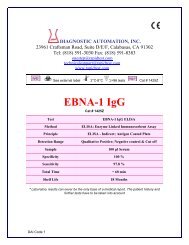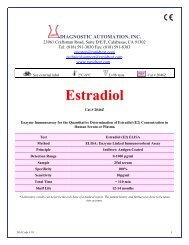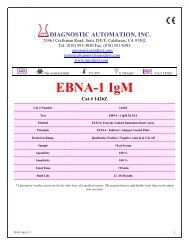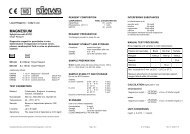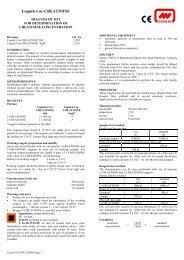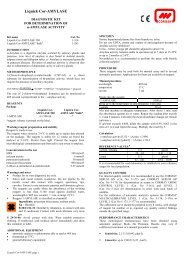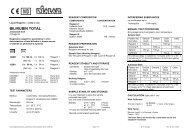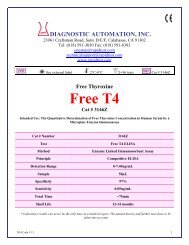Liquick Cor-HBDH
Liquick Cor-HBDH
Liquick Cor-HBDH
Create successful ePaper yourself
Turn your PDF publications into a flip-book with our unique Google optimized e-Paper software.
<strong>Liquick</strong> <strong>Cor</strong>-<strong>HBDH</strong><br />
DIAGNOSTIC KIT<br />
FOR DETERMINATION OF<br />
α-HYDROXYBUTYRATE<br />
DEHYDROGENASE ACTIVITY<br />
Kit name<br />
Cat. No<br />
<strong>Liquick</strong> <strong>Cor</strong>-<strong>HBDH</strong> 500 1-316<br />
<strong>Liquick</strong> <strong>Cor</strong>-<strong>HBDH</strong> “bulk” 1-285<br />
INTRODUCTION<br />
Lactate dehydrogenase (LDH, LD) is a tetrameric molecule<br />
containing two possible forms of subunits (H and M). The result is<br />
five isoenzymes, one of which is hydroxybutyrate dehydrogenase<br />
(<strong>HBDH</strong>, LD-1) formed by four H subunits. <strong>HBDH</strong> is present mainly<br />
in heart muscle but occur also in kidney and erythrocytes. Normal<br />
serum contains mostly LD-2 with lesser amount of LD-1. Changes in<br />
the ratio of LD-1 to LD-2 indicate myocardial infarction or<br />
hemolysis.<br />
METHOD PRINCIPLE<br />
Metoda kinetyczna zalecana przez Niemieckie Towarzystwo Chemii<br />
Klinicznej (DGKC).<br />
2-oksomaślan + NADH + H + -<strong>HBDH</strong> 2-hydroksymaślan + NAD +<br />
Szybkość zmian absorbancji mierzona przy =340 nm jest wprost<br />
proporcjonalna do aktywności dehydrogenazy -hydroksymaślanowej.<br />
REAGENTS<br />
Package<br />
<strong>Liquick</strong> <strong>Cor</strong>-<br />
<strong>HBDH</strong> 500<br />
1-<strong>HBDH</strong> 3 x 400 ml --*<br />
2-<strong>HBDH</strong> 1 x 300 ml --*<br />
*reagent volume is printed on the label.<br />
<strong>Liquick</strong> <strong>Cor</strong>-<br />
<strong>HBDH</strong> “bulk”<br />
The reagents when stored at 2-8 C are stable up to expiry date<br />
printed on the package. The reagents are stable for 8 weeks on board<br />
the analyser at 2-10 C. Protect from light and avoid contamination!<br />
Working reagent preparation and stability<br />
Assay can be performed with use of separate 1-<strong>HBDH</strong> and 2-<strong>HBDH</strong><br />
reagents or with use of working reagent. For working reagent<br />
preparation mix gently 4 parts of 1-<strong>HBDH</strong> with 1 part of 2-<strong>HBDH</strong>.<br />
Avoid foaming.<br />
Stability of working reagent:<br />
5 days at 2-8 C<br />
24 hours at 15-25 C<br />
Protect from light and avoid contamination!<br />
Concentrations in the test<br />
phosphate buffer (pH 7.5)<br />
2-oxybutyrate<br />
NADH<br />
50 mmol/l<br />
3 mmol/l<br />
0.25 mmol/l<br />
Warnings and notes<br />
• Product for in vitro diagnostic use only.<br />
• The reagents contain < 0.1% sodium azide as a preservative.<br />
Avoid contact with skin and mucous membranes.<br />
• The reagents are usable when absorbance of working reagent is<br />
higher than 1.000 (read against distilled water, wavelength<br />
λ=340 nm, cuvette l=1 cm, at temp. 25 C).<br />
ADDITIONAL EQUIPMENT<br />
• automatic analyzer or photometer able to read at 340 nm (Hg<br />
334 nm, 365 nm);<br />
• thermostat at 25ºC or 37ºC;<br />
• general laboratory equipment;<br />
SPECIMEN<br />
Serum.<br />
Do not use hemolyzed blood because erythrocytes contain very high<br />
<strong>HBDH</strong> activity. Do not chill or freeze samples.<br />
<strong>HBDH</strong> activity is unstable and is rapidly lost during storage.<br />
Specimens can be stored up to 6 hours at 15-25ºC.<br />
Nevertheless it is recommended to perform the assay with freshly<br />
collected samples!<br />
PROCEDURE<br />
These reagents may be used both for manual assay (Sample Start and<br />
Reagent Start method) and in several automatic analysers.<br />
Applications for them are available on request.<br />
Manual procedure<br />
wavelength<br />
temperature<br />
cuvette<br />
340 nm (Hg 334 nm, 365 nm)<br />
25ºC/37 C<br />
1 cm<br />
Sample Start method<br />
Pipette into the cuvette:<br />
working reagent 1000 µl<br />
Bring up to the temperature of determination. Then add:<br />
sample<br />
20 µl (temp. 25ºC)<br />
or<br />
10 µl (temp. 37ºC)<br />
Mix and incubate at adequate temperature. After about 1 min. read<br />
the absorbance against air or water. Repeat the reading after exactly<br />
1, 2 and 3 minutes. Calculate the mean absorbance change per minute<br />
( A/min.).<br />
Calculation<br />
<strong>HBDH</strong> activity [U/l] = A/min. x F<br />
F value depends on the used wavelength:<br />
λ 25ºC 37ºC<br />
340 nm 8095 16030<br />
334 nm 8250 16345<br />
365 nm 15000 29705<br />
Reagent Start method<br />
The determination can be also performed with use of separate<br />
1-<strong>HBDH</strong> and 2-<strong>HBDH</strong> reagents.<br />
Pipette into the cuvette:<br />
1-<strong>HBDH</strong> 1000 µl<br />
Bring up to the temperature of determination. Then add:<br />
sample<br />
20 µl (temp. 25ºC)<br />
or<br />
10 µl (temp. 37ºC)<br />
Mix well, incubate for 1-5 min. Then add:<br />
2-<strong>HBDH</strong> 250 µl<br />
Mix well, perform measurement as described for Sample Start<br />
method.<br />
Calculation<br />
<strong>HBDH</strong> activity [U/l] = A/min. x F<br />
F value depends on the used wavelength:<br />
λ 25ºC 37ºC<br />
340 nm 10080 20000<br />
334 nm 10275 20390<br />
365 nm 18675 37060<br />
<strong>Liquick</strong> <strong>Cor</strong>-<strong>HBDH</strong> page 1
REFERENCE VALUES 1, 7<br />
serum 25ºC 37ºC<br />
adults<br />
55 – 140 U/l<br />
(0.917 – 2.33 µkat/l)<br />
< 182 U/l<br />
(< 3.04 µkat/l)<br />
It is recommended for each laboratory to establish its own reference<br />
ranges for local population.<br />
QUALITY CONTROL<br />
For internal quality control it is recommended to use the CORMAY<br />
SERUM HN (Cat. No 5-172) and CORMAY SERUM HP<br />
(Cat. No 5-173) with each batch of samples.<br />
For the calibration of automatic analysers systems the CORMAY<br />
MULTICALIBRATOR LEVEL 1 (Cat. No 5-174; 5-176) or<br />
LEVEL 2 (Cat. No 5-175; 5-177) is recommended.<br />
The calibration curve should be prepared every 8 weeks, with change<br />
of reagent lot number or as required e.g. quality control findings<br />
outside the specified range.<br />
LITERATURE<br />
1. DGKC: J. Clin. Chem. Clin. Biochem. 8, 658-660 (1970).<br />
2. DGKC: J. Clin. Chem. Clin. Biochem. 10, 281-291 (1972).<br />
3. Elliot B.A., Wilkinson J.H.: Clin. Sci. 24, 343 (1963).<br />
4. Berry A.J., Lott J.A., Grannis G.F.: Clin. Chem. 19/11, 1255-<br />
1258 (1973).<br />
5. Burtis C.A., Ashwood E.R., ed. Tietz Textbook of Clinical<br />
Chemistry, 2nd ed. Philadelphia, PA: WB Saunders, 816-8,<br />
(1994).<br />
6. Tietz N.W., ed. Clinical Guide to Laboratory Tests, 3rd ed.<br />
Philadelphia, PA: WB Saunders, 384 (1995).<br />
7. Dembińska-Kieć A., Naskalski J.W.: Diagnostyka laboratoryjna<br />
z elementami biochemii klinicznej, Volumed, 142-144, 781,<br />
(1998).<br />
Date of issue: 04. 2012.<br />
PERFORMANCE CHARACTERISTICS<br />
These metrological characteristics have been obtained using<br />
automatic analyser Biolis 24i Premium. Results may vary if<br />
a different instrument or a manual procedure is used.<br />
• Sensitivity: 9.2 U/l (0.153 µkat/l).<br />
• Linearity: up to 500 U/l (8.33 µkat/l).<br />
If <strong>HBDH</strong> activity in tested sample exceeds 500 U/l dilute the<br />
sample 10-fold with 0.9% NaCl and repeat the assay. Multiply<br />
the result by 10.<br />
• Specificity / Interferences<br />
Haemoglobin up to 2.5 g/dl, ascorbate up to 62 mg/l, bilirubin<br />
up to 20 mg/dl and triglycerides up to 1000 mg/dl do not<br />
interfere with the test.<br />
• Precision<br />
Repeatability (run to run)<br />
n = 20<br />
level 1<br />
level 2<br />
Mean<br />
[U/l]<br />
141.63<br />
362.68<br />
SD<br />
[U/l]<br />
2.12<br />
4.52<br />
CV<br />
[%]<br />
1.50<br />
1.25<br />
Reproducibility (day to day)<br />
n = 80<br />
level 1<br />
level 2<br />
Mean<br />
[U/l]<br />
148.94<br />
380.33<br />
SD<br />
[U/l]<br />
2.03<br />
3.28<br />
CV<br />
[%]<br />
1.37<br />
0.86<br />
• Method comparison<br />
A comparison between <strong>HBDH</strong> values determined at Biolis 24i<br />
Premium (y) and at Prestige 24i (x) using 101 samples gave<br />
following results:<br />
y = 1.0432 x - 7.6087 U/l;<br />
R = 0.9945<br />
(R – correlation coefficient)<br />
WASTE MANAGEMENT<br />
Please refer to local legal requirements.<br />
MANUFACTURER<br />
PZ CORMAY S.A.<br />
22 Wiosenna Street,<br />
05-092 Łomianki, POLAND<br />
tel.: +48 (0) 22 751 79 10<br />
fax: +48 (0) 22 751 79 14<br />
http://www.cormay.pl<br />
04/12/04/12<br />
<strong>Liquick</strong> <strong>Cor</strong>-<strong>HBDH</strong> page 2






